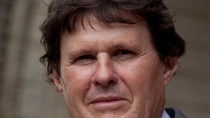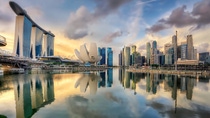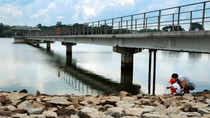Chi siamo
A world of water
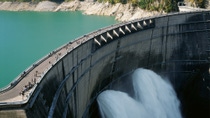
As the global population increases and the impact of climate change is being felt, concerns are rising about how sustainable our future water supplies will be. Former water advisor to the World Bank, Professor John Briscoe, Ph.D., explains that by investing in innovation, smart infrastructure and good institutions, we can be prepared to deal with these changes.
Creating Chemistry: You have dedicated most of your career to water. What sparked your initial interest in this resource?
Professor John Briscoe, Ph.D.: Very simple, I am from South Africa and grew up in a country in which the rain falls on the coast and God put the diamonds and the gold a long way from the rain and in a big rain shadow. The country subsists on very large hydraulic programs to move water from where it is, to where the people and the economy are. I grew up with a sense of the value of water and the threat of water scarcity, so in that sense it is very visceral for me. I studied civil engineering in Cape Town and I discovered that water is such an amazing subject. You have to know engineering; you have to know finance, economics, public health, religion and politics. It is a great area for people who have a wide range of intellectual interests, which is my case. It has been my privilege to live in Bangladesh, Mozambique, India and Brazil and work in dozens of other countries on these issues over the last 40 years. I now feel like I know 10% of what I need to know!
You are now director of the Harvard Water Security Initiative, a cross-disciplinary research program that you set up within the Harvard School of Engineering and Applied Sciences. What are its aims?
There are two main bumper stickers for the program. The first is to create a new type of professional for modern water management. In dealing with water you need good engineers, good lawyers, good economists, good agronomists and good energy people. You need specialists who can communicate with other specialists. So the first bumper sticker is to train a new generation of ‘specialized integrators,’ strong in their basic discipline but capable of dealing with other disciplines. The second issue is that in the water world there is a great disconnect between the ‘high-thinkers’ and the practical reality. So the second bumper sticker is to link students with ‘thinking practitioners.’ We also work primarily in places where I have decades of hands-on experience and so focus on just four geographies – Brazil, Australia, Pakistan and the Mississippi.
The planet’s population is growing as we experience the impact of climate change with flooding in Pakistan, drought in Australia, shifts in Indian monsoon patterns and the potential filling of Cyprus’s exhausted aquifers with saltwater. How serious a situation do you think we are in?
First of all, when dealing with water there is no ‘we,’ every water situation is local. The water situation in Massachusetts and the one in California are essentially independent problems. There is thus no world water crisis. There are a multitude of local issues, each one with quite distinct characteristics.
Secondly, we have always had droughts and floods; they are biblical and they did not start in 1997. Climate change certainly adds an element of uncertainty. The recent floods in Europe – is that a climate event? Probably in part so, but it is much more definitively a land use issue, which is a consequence of the occupation of floodplains.
Thirdly, in water the glass is always half full. It is true that we face a lot of floods and droughts, but we have some examples of good adaptive practices. To cite just two examples where we work, Australia is the best in the world at dealing with water shortage and the Mississippi River Commission has done a brilliant job with managing floods. We have a lot of practical, field-tested knowledge of what works. As a practitioner, my view is that too much attention is given to producing colored graphs about how the world is going to be a catastrophe in 2080 and far too little attention is given to recognizing that hydrological variability is a long-established fact of life and that our first focus should be on creating resilience to known variability. Those who have dealt with known variability are much better equipped to manage a variety of unknowns, be it climate or other shocks.
280,000
Over the past 20 years, every single day about 280,000 people have obtained access to an adequate supply of drinking water for the first time.
80%
Rich countries have used 80% of their economically viable hydroelectric potential. The equivalent number for Africa is 5%.
70%
Murray Darling Basin in Australia has experienced a 70% reduction in water availability. But as a result of well-functioning market mechanisms to move water use from low-value to high-value uses, there was virtually no impact on agricultural value.
Populations are increasingly concentrating in cities. What challenge does this pose to the delivery of sustainable urban water supplies?
I don’t see urbanization as an insurmountable problem. Yes, of course, there are many problems, but they are no worse than they have ever been. London in the 1850s was not a lovely bucolic city in which to live. In most instances things are getting better. A critical issue, however, is the availability of resources. It is much easier to address the problem of flooding in, say, New York or Shanghai than it is in, say, Lagos or Kolkata. So while we do need to be more proactive and adaptive in all cities, in the developing world a primary focus must remain economic growth and the enhanced productivity of cities.
How do we deal with the 10% of the world’s population who lack access to safe water?
It is important to recognize the extraordinary progress that has been made on this challenge. Over the past 20 years, every single day about 280,000 people have obtained access to an adequate supply of drinking water for the first time. Almost all of this progress has been the result of economic growth. Poor people don’t have many things, such as jobs, transport, healthcare, education or food. Water supply and sanitation are pieces of a bigger picture and you cannot solve them without addressing that. Where economies grow, there is broad improvement and the water supply issue is solved as part of this. That is how we in the developed world got safe water. These are crippling issues for poor people but they are not going to be solved without growth and sound financial policies.
Is there a role for business when it comes to providing adequate water management in the developing world?
In the developing world, a huge issue is that the basics, such as a good legal and regulatory framework and good management capacity in the public sector, are not in place. If you can get multinational companies to work with local companies and have them assist the government in strengthening these core capabilities then this can make a tremendous difference. Companies need to engage with political leaders and find ways in which they can support with money and knowledge the capacity of governments to manage water more effectively. This is much more important than the typical ‘give a donation to an NGO’ approach of most companies.
What sorts of innovations are needed to help achieve sustainable water management?
I see three main areas where technologies can help. First, remembering that 70% of water is used in agriculture, a critical issue is that we need to use science and innovation to produce the types of crops that can use less fertilizer, less pesticide and water more efficiently. This is absolutely central. Among the tools for achieving this must be genetically modified organisms. The European position on GMOs is, in my view, very harmful to the environment and to development.
The second area is treatment technology. The most discussed is desalination, where, ironically, the technology has reached its thermodynamic limit and there is likely to be little change. But through the application of nanotechnology we are now able to design membranes to meet very specific treatment requirements. This means technology can be tailored to clean particular types of wastewater in an effective way and reuse them. This is hugely important and a chemical company like BASF has a tremendous role to play.
Third, we need to use information much more intensively and intelligently. The use of sensometers, remote sensing, big data analysis and just-in-time delivery mechanisms already play a fundamental role in advanced water management systems like in Australia and are of great importance in most places. These innovations are central to us adapting, so they are very important.
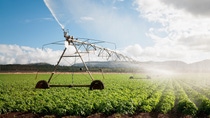
What do you see as the role of hydroelectric power in meeting future energy needs?
Hydro is almost always a source of low-carbon energy. Rich countries have used 80% of their economically viable hydroelectric potential. Switzerland, Norway, Japan, the United States and Canada used hydro as a backbone of their economic development, and it remains so to this day. The equivalent number for Africa is 5%. Yet, well-meaning people from rich countries tell poor countries that they will not support hydro. This is deeply and, in my view, appropriately resented as a form of colonialism at worst and moral hazard at best. Developing countries have a straightforward view of development. They want to follow the path that now-rich countries have followed. For sure they want to learn from mistakes that were made, but they are not willing to serve as guinea pigs for rich people’s experiments on ‘alternative paths.’

How do you respond to critics of dams who claim they displace populations, add to climate change and destroy down-river ecosystems?
All big innovations have big upsides and big downsides. So it is with dams. Most large dams have brought great benefits in terms of protection from floods and droughts, production of clean and cheap electricity and food production. But there are downsides too. One relates to the impacts on the environment, which we are learning to mitigate. In most of the developing world, however, the big issue is resettlement. Changing where people live involuntarily is always traumatic. A great deal has been learned and much progress made in recent decades. The philosophy here is that local people must be the first beneficiaries from these projects and there are cases of this working well.
Access to water has always been a source of possible conflict between communities. How big a threat do water wars pose today?
The word ‘rivals’ comes from the Latin rivalis, which refers to someone using the same river as another, so conflict over water has been going on for a while. But the simple fact is that few wars have actually been fought over water. The idea that the United States and Canada would go to war over water is absurd because water is one of hundreds of issues they deal with. If, on the other hand, you look at Pakistan and India, they have very few ties that bind and thus a highly sensitive and political issue like water becomes one of the few issues on which the countries have worked together. This is the case with the Indus Basin, which is a very dangerous potential flashpoint.
There have been great changes in approach since you started working in water management 40 years ago. What changes do you expect to see 40 years from now?
If we have economic growth then we will have a lot more ability to deal with difficult problems. This is particularly important for the still-poor parts of the world. I also hope we can act more intelligently. We know that we can deal with extremes – both floods and droughts – better. Let me give you two examples where our work at the Harvard Water Security Initiative illustrates this: In Australia, there has been a 70% reduction in water availability in the Murray Darling Basin over a period of eight years and virtually no impact on agricultural value.
The basic reason this worked was because market mechanisms meant that water moved voluntarily from low-value uses such as rice to high-value uses such as fruits when water was scarce. On the flood side, the Mississippi is a fascinating case. Two years ago, they had the biggest floods since 1927, which, at the time, had been the biggest natural disaster in the history of the Unites States.
In 2011 when they had the floods, no one in the United States knew it had happened; the area submerged was 30% of what it was in 1927. In 2011, not a drop of water went to a place that was not designated to receive this water. Lessons are learned and are then put into practice. Again, details will differ by place, but the philosophy of ‘making room for the river,’ building smart infrastructure and good institutions is a constant.
What are the water issues where you live today and how do you take care in the way you use water in your own daily life?
I live in a small New England town of 5,000 people in the United States. We live on a man-made pond and we have a little dam down at the end and I am the dam master.
The residents love to have the pond full, but if there is a lot of rain and it gets too full we can lose our dam, so you have to watch the level. My wife is a keen observer and she says ‘I think it is low enough now we can put the boards back.’ We have a lot of fun managing our own dam!
